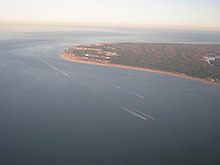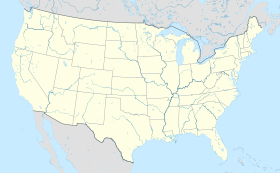Virginia Beach, Virginia
Virginia Beach | |
|---|---|
 Virginia Beach from the pier | |
| Nickname(s): "The Resort City", VA Beach | |
| Motto: Landmarks of Our Nation's Beginning | |
 Interactive map of Virginia Beach | |
| Coordinates: 36°51′00″N 75°58′40″W / 36.85000°N 75.97778°W | |
| Country | |
| State | |
| Incorporated (town) | 1906 |
| Incorporated (city) | 1952 |
| Government | |
| • Type | Mayor–council–manager |
| • Mayor | Bobby Dyer (R) |
| Area | |
| • Independent city | 497.50 sq mi (1,288.52 km2) |
| • Land | 244.72 sq mi (633.83 km2) |
| • Water | 252.78 sq mi (654.69 km2) |
| Elevation | 10 ft (3 m) |
| Population | |
| • Independent city | 457,672 |
| • Rank | US: 43rd VA: 1st |
| • Density | 1,877.5/sq mi (724.9/km2) |
| • Urban | 1,451,578 (US: 36th) |
| • Urban density | 3,013.6/sq mi (1,163.6/km2) |
| • Metro | 1,799,674 (US: 37th) |
| Time zone | UTC−05:00 (EST) |
| • Summer (DST) | UTC−04:00 (EDT) |
| ZIP Codes | 23450-23467, 23471, 23479 |
| Area code(s) | 757, 948 |
| FIPS code | 51-82000[4] |
| GNIS feature ID | 1500261[5] |
| Website | Official website |
Virginia Beach is an American city in the Commonwealth of Virginia. The city is in the South Hampton Roads area on the shores of the Chesapeake Bay and the Atlantic Ocean. It is the largest city in Virginia. It is the 42nd largest city in the United States. There are people living there.[6]
Virginia Beach is a part of the Virginia Beach-Norfolk-Newport News metropolitan area. The area also includes the cities of Chesapeake, Hampton, Newport News, Norfolk, Portsmouth, and Suffolk, as well as other smaller cities, counties and towns of Hampton Roads. The area is known as "America's First Region."
Virginia Beach is best known as a resort town. It has miles of beaches and hundreds of hotels, motels, and restaurants along the Atlantic Ocean and Chesapeake Bay. It is also home to several state parks, three military bases, a number of large corporations, and two universities. It was the site of the first landing of English colonists going to Jamestown.
The city is listed in the Guinness Book of Records as having the longest pleasure beach in the world.[7] It is also at the southern end of the Chesapeake Bay Bridge-Tunnel, the longest bridge-tunnel in the world.
History
[change | change source]Native Americans
[change | change source]Chesepians were the Native American (American Indian) people living in the area now known as South Hampton Roads in Virginia during the time the English settlers came in 1607. They lived in an area which is now the cities of Norfolk, Portsmouth, Chesapeake and Virginia Beach.
The Chesepians had two other towns (or villages), Apasus and Chesepioc. Both were near the Chesapeake Bay in what is now Virginia Beach. Archaeologists and other people have found many Native American artifacts, for example arrowheads, stone axes, pottery, beads, and skeletons in the area.
First landing, Adam Thoroughgood
[change | change source]
In 1607, after traveling by ocean for 144 days, three ships headed by Captain Christopher Newport came to land where the Atlantic Ocean meets the southern mouth of the Chesapeake Bay. This point is in the northeastern part of the city. They named it Cape Henry, after Henry Frederick, Prince of Wales, the oldest son of King James I of England. They then left the area to find a place farther inland where ships from other European countries would not find them. They created their first settlement at Jamestown.
Adam Thoroughgood (1604-1640) of Norfolk, England is one of the first Englishmen to settle in the area which became Virginia Beach.
In 1634, the Colony was divided into shires. They were soon renamed counties. It is said that Thoroughgood used the name of his home in England when helping name New Norfolk County in 1637. The following year, New Norfolk County was split into Upper Norfolk County (soon renamed Nansemond County) and Lower Norfolk County. Thoroughgood chose to live along the Lynnhaven River, also named for his home in England. Lower Norfolk County was very big. It stretched all the way from the Atlantic Ocean west past the Elizabeth River. It included the entire area that is now the cities of Portsmouth, Norfolk, Chesapeake, and Virginia Beach.
Princess Anne County: 1691-1963
[change | change source]In 1691, Lower Norfolk County was divided to form Norfolk County to the west and Princess Anne County to the east. Princess Anne included all the area from North Carolina border to Cape Henry at the mouth of the Chesapeake Bay along the Atlantic Ocean. Princess Anne County existed from 1691 to 1963, over 250 years.
Virginia Beach: growth of a resort
[change | change source]The small resort area of Virginia Beach began to grow in Princess Anne County in the late 19th century. This growth was helped in 1888 when rail service and electricity started in the area.
The resort was dependent upon railroad and electric trolley service at first. The concrete Virginia Beach Boulevard from Norfolk to the Oceanfront was completed in 1922. It let people get to the oceanfront in automobiles, buses, and trucks. The resort of Virginia Beach became an incorporated town in 1906. Over the next 45 years, Virginia Beach became more popular as a summer vacation spot. Virginia Beach became a small independent city in 1952. It was politically independent from Princess Anne County. In 1963, Virginia Beach and Princess Anne county merged into a new, much larger independent city keeping the name of the Virginia Beach resort.
On May 31, 2019, there was a mass shooting in the city. A man killed 12 people. He was killed by police.
Geography and climate
[change | change source]Geography
[change | change source]Virginia Beach has an area of 1,288.1 km² (497.3 mi²). Of that area, 643.1 km² (248.3 mi²) is land and 645.0 km² (249.0 mi²) is water. The average elevation is 12 feet (4 meters) above sea level.
The city has a humid subtropical climate (Cfa in the Koeppen climate classification).
Things to see
[change | change source]- Adam Keeling House
- Adam Thoroughgood House
- Cape Henry
- Fleet Combat Training Center Atlantic
- Fort Story
- Hell's Point Country Club
- Little Creek Naval Amphibious Base
- Naval Air Station Oceana
- Norwegian Lady Statue
- Old Cape Henry Lighthouse
- Old Coast Guard Station Museum (Seatack)
- Regent University and Christian Broadcasting Network
- TPC of Virginia Beach
- Verizon Wireless Virginia Beach Amphitheater
- Virginia Aquarium
- Virginia Beach Oceanfront
The Edgar Cayce Hospital for Research and Enlightenment was started in Virginia Beach in 1928 with 60 beds. Cayce was a psychic from Kentucky who said he had healing abilities and made prophesies. Cayce lived in Virginia Beach until he died in 1945. His followers are still active in Virginia Beach. Atlantic University was opened by Cayce in 1930; it closed two years later but was re-opened in 1985. Atlantic University was originally intended for study of Cayce's readings and research after spiritual subjects.
There are also eleven golf courses open to the public in the city, as well as four country club courses and NAS Oceana's Aeropines course. Among the best-known public courses are Hell's Point Golf Club and the TPC of Virginia Beach.
Military bases
[change | change source]Virginia Beach is home to several United States Military bases. These include the United States Navy's NAS Oceana and FTC Dam Neck, and the United States Army's Fort Story at Cape Henry. NAB Little Creek is mostly in the city of Virginia Beach but has a Norfolk address.
NAS Oceana is the largest employer in Virginia Beach. It is said to the largest naval airbase in the world.
Sister cities
[change | change source]Virginia Beach has three Sister Cities:[8]
References
[change | change source]- ↑ "2019 U.S. Gazetteer Files". United States Census Bureau. Retrieved August 7, 2020.
- ↑ "QuickFacts: Virginia Beach city, Virginia". United States Census Bureau. Retrieved September 1, 2021.
- ↑ "2020 Population and Housing State Data". United States Census Bureau. Retrieved August 22, 2021.
- ↑ "U.S. Census website". United States Census Bureau. Retrieved January 31, 2008.
- ↑ "US Board on Geographic Names". United States Geological Survey. October 25, 2007. Retrieved January 31, 2008.
- ↑ U.S. Census Bureau, 2004 Population Estimates, Census 2000, 1990 Census: http://factfinder.census.gov/ Archived 2020-02-12 at Archive.today
- ↑ Blogger, Travel (2012-09-12). "Virginia Beach also the World's Longest Stretch of Pleasure Beach". Trip and Travel Blog. Retrieved 2023-05-08.
- ↑ Sister Cities designated by Sister Cities International, Inc. (SCI). Retrieved June 6, 2006.
Other websites
[change | change source]- Official Government Website Archived 2000-04-08 at the Wayback Machine
- Tourism Website Since 1995 www.va-beach.com
- Convention & Visitors Bureau Archived 2008-08-20 at the Wayback Machine
- Virginia Beach City Page Archived 2006-05-08 at the Wayback Machine Virginia is for Lovers
- Map of Virginia Beach Archived 2013-01-13 at the Wayback Machine
- Pictures of Virginia Beach Archived 2007-06-29 at the Wayback Machine
- City of Virginia Beach Online Geographic Information[permanent dead link]






